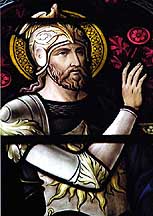Stained Glass - Table of Contents
John Hardman and Company
Birmingham, England
John
Hardman Trading Co., Ltd. - Official Website

|
A human dynamo who burned himself out at the age of forty, Augustus Welby Northmore Pugin (POO jin) is generally acknowledged as the most influential architect, designer, and propagandist of the nineteenth-century Gothic revival in England. Less well known are the entrepreneurs and manufacturers without whom Pugin could not have translated his medieval dreams into reality, and who spread his principles of Gothic design across the world. Chief among those who produced items for the American ecclesiastical market was John Hardman Jr. (1811-1867), a member of a Birmingham metalworking family. Better known simply as John Hardman and Company, the firm began in 1845 to design and manufacture stained-glass windows, motivated once again by Pugin. A showroom designed by Pugin was established in Birmingham's Great Charles Street to display the full range of Hardman's products, and printed catalogues were also produced so that goods could be ordered by mail.
|
|
Hardman
& Co. (in 2009 John Hardman Trading Co., Ltd.),
founded 1838, began manufacturing stained glass in 1844 and became one of the world's
leading manufacturers of stained glass and ecclesiastical fittings. Powell became the chief designer from about 1849, prior to Pugin's death in 1852. Hardman and Powell collaborated with A. W. Pugin's son, E. W. Pugin, firstly in 1852. For three generations this collaboration was an essential ingredient of their successful domination of Catholic church architecture and decoration in particular and of their influence in the Gothic Revival in general. The most famous building that the Hardmans made glass for was the new Houses of Parliament in London, for which Pugin was the interior designer. Pugin employed the Scottish firm of Ballantine and Allen to manufacture the windows that he designed for the House of Lords, but all the rest were made by Hardmans, who have maintained their relationship with that building, repairing and replacing glass damaged or destroyed during World War II. [The company] exhibited works at the Philadelphia Exhibition of 1873, influencing stained glass in the United States of America. |
|
In the 1930s the number of American stained-glass window commissions from Hardman's declined rapidly, and in 1935 they ceased altogether. The United States now had competent stained-glass designers and manufacturers of its own, notably the Boston studio of Charles J. Connick (1875-1945), much favored by Ralph Adams Cram. The Great Depression and the onset of World War II also took their toll. In the postwar Catholic Church, the liturgical revolution fueled by the Second Vatican Council accorded ill with the medieval aesthetic of Pugin and Hardman. The last of the Hardmans to be directly involved with the company, the founder's grandson John Tarleton Hardman, died in 1959, by which time the metalwork production that had provided the firm's initial impetus had already ceased.
|
"Many firms continued a more painterly approach, taking Victorian illustrative work well into the twentieth century. Hardman's Burmingham studio changed from the faithful thirteenth-century model that it executed for Pugin to more pictorial compositions." - Virginia Chieffo Raguin, Stained Glass: From Its Origins to the Present, 2003, p. 191
Examples in Buffalo:
- Saint Paul Episcopal Cathedral: St.
Paul's Farewell to The Elders of Ephesus at Miletus / The
Transfiguration of Christ / Joshua
- Saint Joseph RC Cathedral: St.
Charles Borromeo and Saint Edward the Confessor
- Trinity Episcopal Church: Elijah Feeding in the Wilderness; Mary and Martha
- Episcopal Church of the Ascension: Presentation in the Temple
- Is Pentecost, also in the Episcopal Church of the Ascension, a Hardman?
Outside of Buffalo:
- Dossin Great Lakes Museum, Belle Isle, Detroit, MI: The French Led by La Salle Discover Detroit
